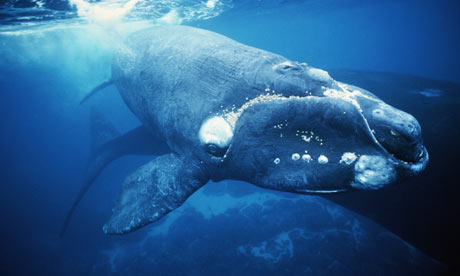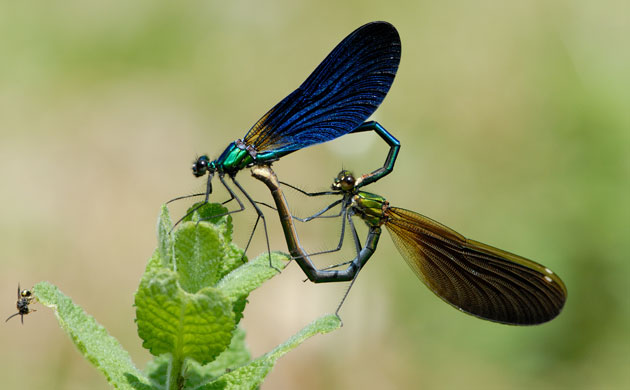TOP STORIES  Whale experts meet to solve mystery deaths of southern right species
Whale experts meet to solve mystery deaths of southern right species
More than 300 southern right whales have been found dead in the last five years in the waters off Argentina's Patagonian coast
Experts are meeting this week to try to solve the mystery of the largest ever recorded die-off of great whales.
More than 300 southern right whales, most of them young calves, have been found dead in the last five years in the waters off Argentina's Patagonian coast - one of the most important breeding grounds for the species.
Possible causes being examined include biotoxins - naturally occurring poisons which include the venom of some snakes and spiders and the "flesh-eating" bacteria Necrotizing fasciitis - disease, environmental factors, and lack of prey, particularly the tiny krill which make up the bulk of the southern right's diet. Another theory put forward has been the effect of gulls, which can act like parasites, gouging skin and blubber from the whales' backs.
The main evidence that will be examined is tests on samples taken from beached whale calves, which have shown "unusually thin" blubber, said the US-based Wildlife Conservation Society, which described the die-off as "a perplexing and urgent mystery".
17 Mar 2010
J Jowit Photo courtesy of The Guardian
Location: Argentina - Map It

 Scottish bird of prey poisonings rise to near record levels
Scottish bird of prey poisonings rise to near record levelsEnvironment minister says 27 protected birds of prey were poisoned in 2009, one of the worst years on record for the crime
The Scottish government has been accused of failing to tackle wildlife crime after the latest figures disclosed that 2009 was one of the worst years on record for bird of prey poisonings.
The Scottish environment minister, Roseanna Cunningham, said that 27 protected birds of prey were proven to have been poisoned last year, including two golden eagles, 19 buzzards and four red kites, in 22 separate incidents.
An updated map of persecution "hotspots" confirmed that the Angus glens in the southern Cairngorms, the Borders south of Edinburgh and Perthshire remained areas where the greatest number of confirmed incidents took place.
16 Mar 2010
S Carrell
Photo courtesy of The Guardian
Location: Scotland - Map It

High Arctic Species on Thin Ice
A new assessment of the Arctic's biodiversity reports a 26 per cent decline in species populations in the high Arctic.
Populations of lemmings, caribou and red knot are some of the species that have experienced declines over the past 34 years, according to the first report from The Arctic Species Trend Index (ASTI), which provides crucial information on how the Arctic's ecosystems and wildlife are responding to environmental change.
Science Daily - www.sciencedaily.com
17 Mar 2010
OTHER WILDLIFE HEALTH RELATED NEWS
Photo courtesy of The Guardian
 High Levels of Mercury Found in Cataraqui River, Kingston, Ontario, Canada
High Levels of Mercury Found in Cataraqui River, Kingston, Ontario, Canada- Myanmar a gateway for wildlife trade to China: report
- Shark conservation proposal defeated at UN meeting
- Habitat loss wiping out Europe's butterflies
- Europe's butterflies, beetles and dragonflies under threat [image gallery]
WILDLIFE HEALTH RELATED PUBLICATIONS
Browse complete Digest publication library here.
 Climate change increases the likelihood of catastrophic avian mortality events during extreme heat waves
Climate change increases the likelihood of catastrophic avian mortality events during extreme heat wavesBiol Lett. 2010 Apr 23;6(2):253-6. Epub 2009 Sep 30.
AE McKechnie and BO Wolf
A novel herpesvirus in the sanctuary chimpanzees on Ngamba Island in Uganda
J Med Primatol. 2010 Feb;39(1):71-6. Epub 2009 Nov 9.
L Mugisha et al.
Pharmaceuticals in the aquatic environment: A critical review of the evidence for health effects in fish
Crit Rev Toxicol. 2010 Mar 15. [Epub ahead of print]
J Corcoran et al.
Establishing a serological surveillance protocol for rabbit hemorrhagic disease by combining mathematical models and field data: implication for rabbit conservation
Journal European Journal of Wildlife Research. 2010; [Epub ahead of print]
I Cotilla et al.
Sedation at Sea of Entangled North Atlantic Right Whales (Eubalaena glacialis) to Enhance Disentanglement
PLoS One. 2010 Mar 9;5(3):e9597.
M Moore et al.




